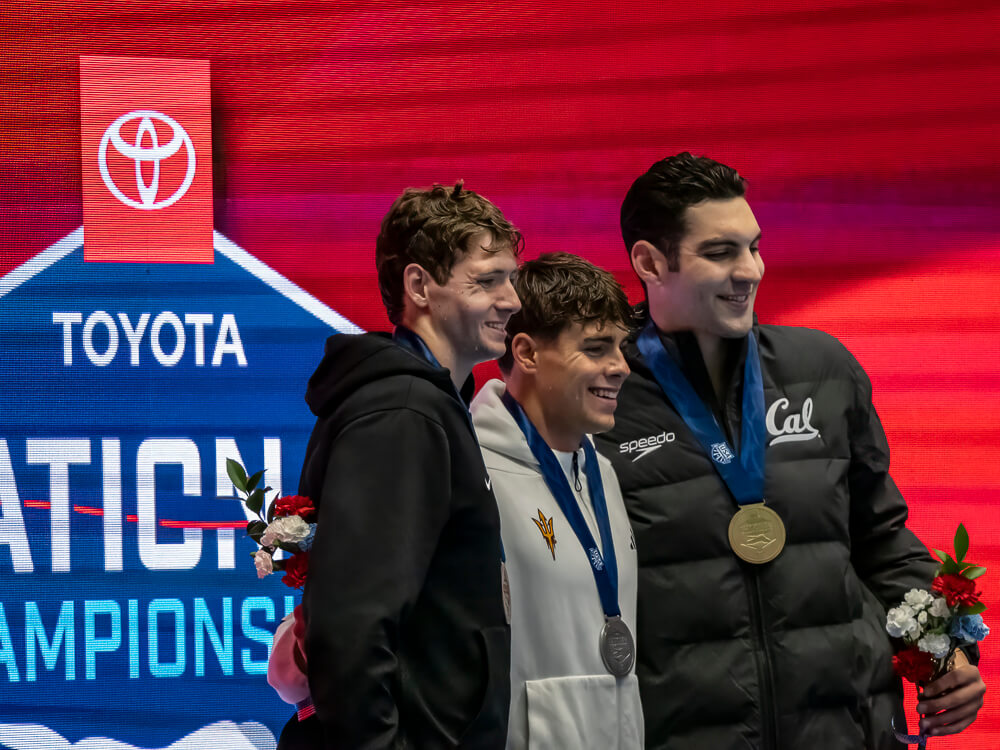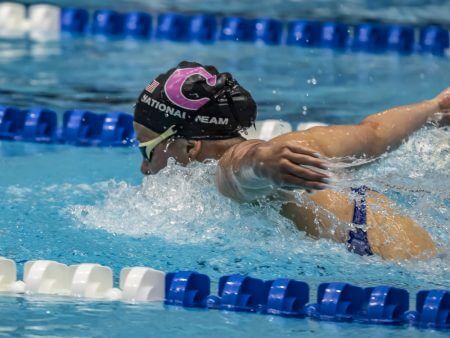Start of U.S. Nationals Has Provided Reminder of Classic American Depth

Opening of U.S. Nationals Has Provided Reminder of Classic American Depth
This year’s U.S. Nationals stand in stark contrast to the Olympic selection meet contested a full blocks away at Lucas Oil Stadium 12 months ago. Rather than record-breaking crowds in a football stadium, only the western grandstand is open to spectators at Indiana University Natatorium. Plenty of Olympic stars are away from the sport, temporarily or permanently; same with numerous college standouts, leaving a far more intimate competition.
Make no mistake, though: the magic and drama of an American selection meet is alive and well.
Swimmers ranked No. 3 in the world have already missed the World Championships team. NCAA champions are taking their talents to long course. The oft-repeated claim that American depth produces quicker swims is proving true in the early going. And on the flip side, veterans of all ages have been reminded that spots on major teams are never guaranteed.
Consider the results of the meet’s first men’s final, where Luca Urlando and Carson Foster claimed their spots in Singapore in the 200 butterfly, with both men clocking 1:53s. Thomas Heilman, the teenager who burst onto the global scene at this meet two years ago, was locked out of contention despite clocking 1:54.03, the second-quickest time of his career by a large margin.
The long course season is still young, but Poland’s Krzysztof Chmielewski has the best non-American time this year at 1:54.36. Heilman missing the Worlds team in his best event cannot be attributed to a poor swim.

Alex Shackell — Photo Courtesy: Peter H. Bick
The same is true of Alex Shackell, whose chances of qualifying for another Worlds team are essentially nil after she fell to fourth in the 200 fly final and then missed qualifying for the 200 free final by 18-hundredths. Yes, Shackell faded down the stretch in her main event as Caroline Bricker surged, passing even American-record holder Regan Smith. Still, Shackell’s her best time of 2:06.10, which she achieved at last year’s Olympic Trials and nearly matched at last month’s Fort Lauderdale Pro Series, would not have been enough to beat either Bricker or Smith.
Then there’s Bricker, who placed 12th in the 200 fly at last year’s Olympic Trials while finishing 17th in two other events. Her breakout season at Stanford set her up as a spoiler at this meet in the 400 IM, but she shocked even herself with that 200 fly victory as she knocked more than three seconds from her best time. Two years into her college career at Stanford, she is set up as the breakout star of this meet.
“I definitely did not see a Worlds team in my future at all,” Bricker said. “I was hoping to make some team, maybe World University Games or something. My short course has not really translated over to my long course the past couple of years, so I was just kind of waiting for that to happen.”
The emergence of Bricker could keep Katie Grimes off the Worlds team entirely. Grimes is the Olympic silver medalist in the 400 IM and also the runner-up at the 2022 and 2023 World Championships, but she has struggled mightily in 2025. She finished seventh in the 800 free, more than 15 seconds behind her lifetime best, while Bricker is excelling and Emma Weyant has already clocked 4:33.95 this year.
That’s three medal-winners from Paris already at real risk of missing the Singapore team, and Brooks Curry joined that list after his ninth-place finish in the 200 free prelims. Curry ended up 13-hundredths out of this final after he missed by nine hundredths in the 100 free, his sub-48 B-final swim not a factor in selection — not that it would have mattered with seven men going under 48 in the A-final.
In the 200 free, Curry was second in his heat entering the final length, and he would surely have expected his 1:46.33 in the 200 free prelims to be good enough to make the final, but three men jumped him down the stretch. The usual greatness of Luke Hobson combined with 1:45s from Rex Maurer, Gabriel Jett and Luka Mijatovic made for a quicker-than-expected cutoff time for the top-eight.
The jump in the event is staggering: at last year’s Olympic Trials, Aaron Shackell and Daniel Diehl tied for eighth in the 200 free semifinals at 1:47.00, necessitating a swim-off for the last spot in the final. This time, 15 men went under 1:47, including Shackell and Diehl, and the 1:47.01 of Baylor Nelson relegated him to lane eight of the B-final.
The American men fell to Great Britain in the 800 free relay at the Paris Olympics, but the depth comparison is astounding. With Tom Dean out this year, only three men swam sub-1:46 at Britain’s Trials while fifth place was 1:47.66. That time would have been C-final-worthy at the American selection meet. The four-fastest Americans from prelims already add up to a quicker composite relay than Great Britain, whose team will struggle with Jack McMillan (1:46.49) as the fourth swimmer.
That’s not to say that every event has been sizzling; the U.S. men in particular still have glaring holes, such as in the 200 breaststroke. Andy Dobrzanski finished eighth in prelims at 2:13.09, a full second slower than the 2:12.02 required to qualify merely for semifinals at the 2024 Olympic Trials.
But as a whole, the traditional American depth is shining through in Indianapolis, at least through the first three sessions. Simone Manuel (100 free) and Jillian Cox (800 free) both swam global top-five times, only to be denied individual swims at Worlds. A similar outcome is expected in the 200 back, where teenagers Charlotte Crush and Leah Shackley threw their names into the mix with massive best times in prelims. A time under 2:06 could be required to reach Singapore. No one aside from two-time Olympic champion Kaylee McKeown has been that fast yet in 2025.
A fraction of the Olympic Trials hype has been no problem for the group of hungry Americans assembled in Indianapolis. While numerous big names lay low in the post-Olympic year, the foundation of the next potentially dominant U.S. squad is coming together.




